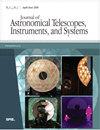Optimized bandpasses for the Habitable Worlds Observatory’s exoEarth survey
IF 3.1
3区 工程技术
Q2 ENGINEERING, AEROSPACE
Journal of Astronomical Telescopes Instruments and Systems
Pub Date : 2024-03-01
DOI:10.1117/1.jatis.10.1.014005
引用次数: 0
Abstract
A primary scientific goal of the future Habitable Worlds Observatory will be the direct detection and characterization of Earth-like planets. Estimates of the exoplanet yields for this concept will help guide mission design through detailed trade studies. It is therefore critical that yield estimation codes optimally adapt observations to the mission’s performance parameters to ensure accurate trade studies. To aid in this, we implement wavelength optimization in yield calculations for the first time, allowing the yield code to determine the ideal detection and characterization bandpasses. We use this capability to confirm the observational wavelength assumptions made for the large UV/Optical/IR surveyor, design B (LUVOIR-B) study, namely that the optimum detection wavelength is 500 nm for the majority of targets and the optimum wavelength to detect water is near 1000 nm, given LUVOIR-B’s assumed instrument performance parameters. We show that including the wavelength-dependent albedo of an Earth twin as a prior provides no significant benefit to the yields of exoEarth candidates and caution against tuning observations to modern Earth twins. We also show that coronagraphs whose inner working angles are similar to step functions may benefit from wavelength optimization and demonstrate how wavelength-dependent instrument performance can impact the optimum wavelengths for detection and characterization. The optimization methods we implement automate wavelength selection and remove uncertainties regarding these choices, helping to adapt the observations to the instrument’s performance parameters.宜居世界天文台外地球探测的优化带通
未来宜居世界观测站的一个主要科学目标是直接探测类地行星并确定其特征。对这一概念的系外行星产量的估计将有助于通过详细的贸易研究来指导飞行任务的设计。因此,产量估算代码必须根据任务的性能参数对观测结果进行最佳调整,以确保贸易研究的准确性。为了帮助实现这一点,我们首次在产出计算中实施了波长优化,使产出代码能够确定理想的探测和表征带通。我们利用这一功能来确认大型紫外/光学/红外勘测仪设计 B(LUVOIR-B)研究中的观测波长假设,即对于大多数目标,最佳探测波长为 500 nm,而根据 LUVOIR-B 假设的仪器性能参数,探测水的最佳波长接近 1000 nm。我们的研究表明,将地球孪生天体随波长变化的反照率作为先验值,对地球外候选天体的检出率没有明显的好处,因此我们告诫不要将观测结果调整为现代地球孪生天体。我们还表明,内部工作角类似于阶跃函数的日冕仪可能会从波长优化中获益,并演示了与波长有关的仪器性能如何影响探测和表征的最佳波长。我们采用的优化方法可以自动选择波长,并消除这些选择的不确定性,有助于使观测与仪器的性能参数相适应。
本文章由计算机程序翻译,如有差异,请以英文原文为准。
求助全文
约1分钟内获得全文
求助全文
来源期刊

Journal of Astronomical Telescopes Instruments and Systems
Engineering-Mechanical Engineering
CiteScore
4.40
自引率
13.00%
发文量
119
期刊介绍:
The Journal of Astronomical Telescopes, Instruments, and Systems publishes peer-reviewed papers reporting on original research in the development, testing, and application of telescopes, instrumentation, techniques, and systems for ground- and space-based astronomy.
 求助内容:
求助内容: 应助结果提醒方式:
应助结果提醒方式:


